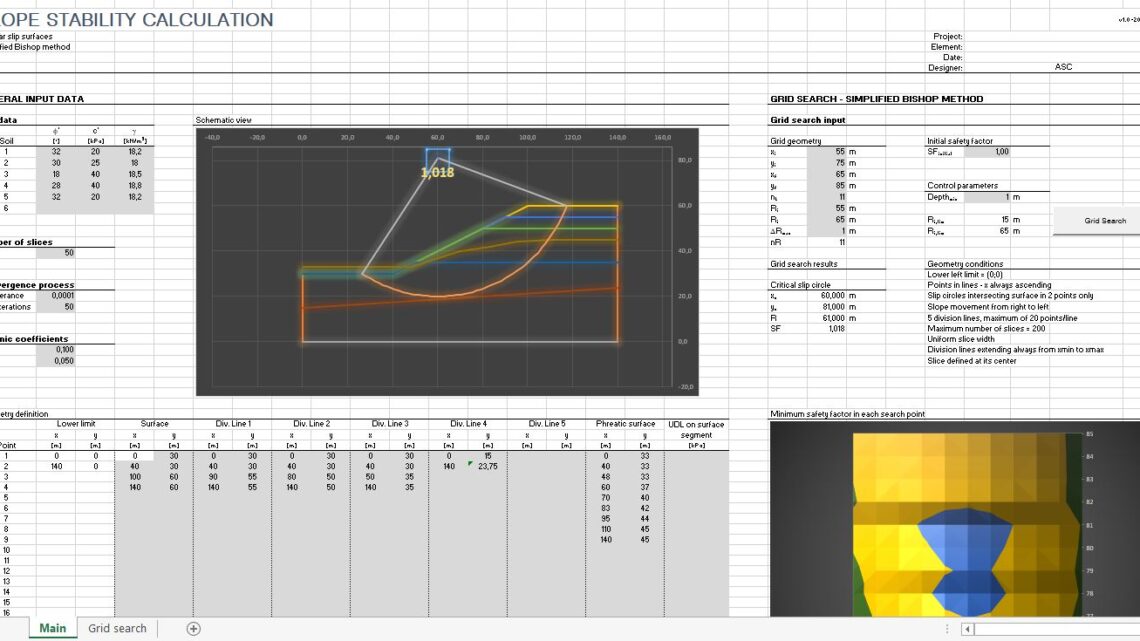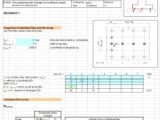
Slope Stability Calculation Simplified Bishop Method Spreadsheet
3 January 2025 Off By The Engineering CommunityTable of Contents
Slope Stability Calculation Simplified Bishop Method Spreadsheet
What is the Bishop Method?
The Bishop Method, also known as Bishop’s Simplified Method, is a widely used approach for analyzing the stability of slopes. Introduced by A.W. Bishop in 1955, this method is part of the limit equilibrium analysis family and focuses on circular failure surfaces. It calculates the factor of safety (FoS) by balancing the driving and resisting forces acting on a slope.
Core Principles of the Bishop Method
The Bishop Method assumes that:
- The potential failure surface is circular.
- The slope is divided into slices to simplify calculations.
- Forces between slices are vertical, neglecting horizontal inter-slice forces.
- Moment equilibrium is used to derive the factor of safety.
This approach uses an iterative process to calculate the FoS, ensuring a balance of forces and moments for the slope. The iterative nature and mathematical rigor make it highly accurate for practical engineering purposes.
How Does the Bishop Method Work?
Here’s a step-by-step breakdown of the Bishop Method:
- Define the Slope Geometry: Begin by defining the slope’s profile, including its height, angle, and material properties.
- Assume a Circular Failure Surface: Identify a potential circular slip surface, which can be adjusted based on trial and error or optimization techniques.
- Divide the Slope into Slices: Break the slope into vertical slices of equal width. This simplifies the complex geometry into manageable segments.
- Calculate Forces for Each Slice: For each slice, calculate the weight, normal force, shear force, and moments. These forces are essential for the stability analysis.
- Iterative Computation of FoS: Use the Bishop equation to iteratively calculate the FoS:
- Refine and Repeat: Adjust the slip surface or refine the calculations until the FoS converges to a stable value.
Applications of the Bishop Method
The Bishop Method is applied across various geotechnical scenarios, including:
- Design of Slopes: Ensuring the stability of natural and artificial slopes in infrastructure projects.
- Embankment Stability: Assessing the safety of dams, levees, and embankments.
- Landslide Analysis: Investigating and mitigating potential landslide hazards.
- Mine Design: Evaluating pit walls and spoil heaps in mining operations.
Advantages of the Bishop Method
The enduring popularity of the Bishop Method can be attributed to several key benefits:
- Simplicity and Practicality: While mathematically robust, the method is straightforward enough for routine use.
- Accuracy for Circular Slips: It is highly accurate for problems involving circular failure surfaces.
- Flexibility: The method can accommodate various soil types and slope geometries.
- Software Integration: Modern geotechnical software often includes the Bishop Method, making it accessible for engineers.
Limitations to Consider
While powerful, the Bishop Method has limitations:
- It assumes circular failure surfaces, which may not always be realistic.
- Horizontal inter-slice forces are neglected, which can impact accuracy in certain conditions.
- It may require considerable computational effort for complex slopes.
Tips for Using the Bishop Method Effectively
To get the most out of the Bishop Method:
- Use Software Tools: Programs like GeoStudio, Slide, and PLAXIS can streamline calculations and visualization.
- Validate Assumptions: Ensure the assumed circular slip surface aligns with the slope’s geology.
- Combine with Other Methods: For non-circular failure surfaces, complement the Bishop Method with alternatives like Janbu’s or Spencer’s Method.
Why the Bishop Method Stands Out
The Bishop Method’s enduring relevance stems from its balance of simplicity, accuracy, and adaptability. It remains a cornerstone in geotechnical engineering, empowering professionals to design safer and more reliable slopes. Whether you’re analyzing a hillside highway or a mining pit, mastering the Bishop Method ensures a firm foundation for your work.


